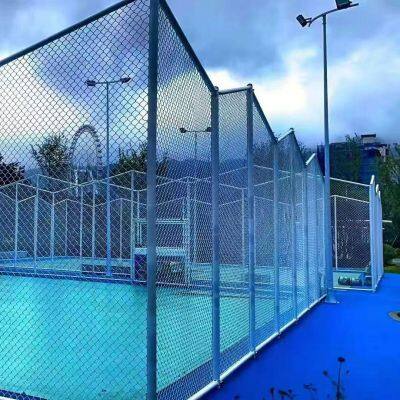-
 Liu
Hi there! Welcome to my shop. Let me know if you have any questions.
Liu
Hi there! Welcome to my shop. Let me know if you have any questions.
Your message has exceeded the limit.

How High Should a Fence Be Around a Basketball Court?
2025-10-11 15:46:19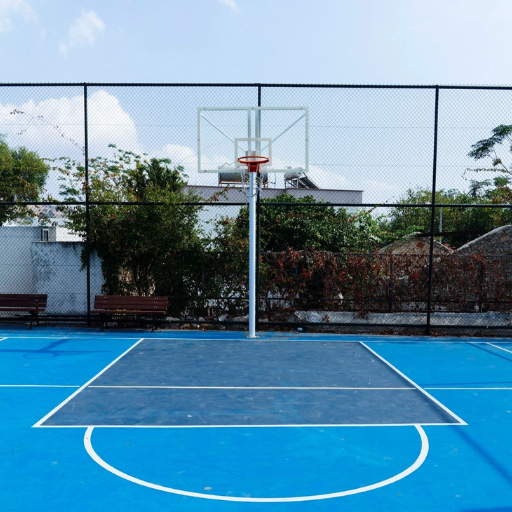
A vital aspect that is often overlooked when building a basketball court is the height of the fence around it. It might seem that the fence is an insignificant detail, but it is actually a crucial factor in the safety and enjoyment of the players. By having the right fence height, not only is the basketball kept inside the court, but pedestrians, cars, and nearby properties are also protected from stray balls. The height of the fence around a basketball court is determined by many factors, such as safety measures for players and local authorities' regulations, which this article intends to discuss. Thus, providing you with valuable information to make a decision. If you are considering building a public sports facility or a private basketball court in your backyard, this guide will be invaluable to you. Find more info now.
Understanding the Importance of a Basketball Court Fence
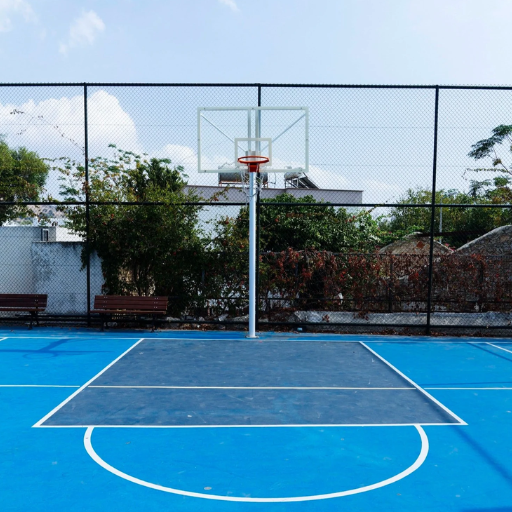
A fence around a basketball court acts as a safety measure and protector of the playground. First, it ensures player safety by keeping the balls on the court, which also protects passing pedestrians and vehicles from the risk of accidents or injuries. Second, it clearly marks the court and, therefore, reduces the disturbances during the game, thus, the area is still playable. Lastly, the fences protect the court from damage caused by dirt, animals, or unauthorized people. These roles make fences a must-have for both public and private basketball courts.
Benefits of Installing a Basketball Court Fence
Enhanced Player Safety
The installation of a fence around the basketball court serves to delimit the area and to keep the balls within the court, thereby lessening the possibility of accidents with the audience or cars. Also, it locks in the players, allowing them to concentrate on the game without worrying about any outside interference.
Defined Playing Boundaries
The fencing clearly marks the limits of the court, thus preventing the game from being interrupted very often. The playing is conducted fairly, and all players have equal access to the courts, especially in areas with multiple courts or shared facilities.
Reduced Maintenance Costs
The fence shields the court from being littered with leaves, or other trash, and materials. Moreover, it can keep intruders away and prevent vandalism, so the court surface wears less and maintenance costs are reduced overall.
Improved Court Privacy
The fence can provide a sense of privacy, especially in residential courts or private facilities. It creates a more exclusive atmosphere, which is more inviting to both players and organizers.
Compliance with Regulations
Fencing around the basketball courts is required by many local laws or sports facility rules to ensure safety measures are followed. Therefore, proper fencing in cooperation with these regulations keeps the court in good standing as a legal and usable space.
Specific Needs for Different Types of Courts
The specific needs can be very different when it comes to the design and construction of courts, depending on the type and intended use of the court. Here are five major types of courts with their distinctive requirements:
Basketball Courts
Surface Material: Smooth asphalt or polyurethane surfaces that give good grip and lower injuries.
Hoop Specifications: A height of 10 feet, set by the regulations, with breakaway rims for safety.
Court Dimensions: 94 ft by 50 ft for professional courts, as per NBA rules.
Fencing: Strong fencing to keep the ball within and the audience safe.
Lighting: Powerful, uniformly scattered lighting for play in both day and night.
Tennis Courts
Available Surfaces: Clay, grass, or hardcourt surfaces in accordance with the level and style of play.
Net System: Nets that can be adjusted and are up to international standards, usually 3 ft high in the center.
Drainage: Water drainage systems that work effectively to avoid surface damage.
Perimeter Clearance: Sufficient space for the players’ safety and comfort around the court.
Wind Barriers: Windscreens or fencing to lessen outside disturbances.
Soccer Fields
Turf Type: Either natural grass or synthetic turf depending on the location and maintenance preferences.
Field Sizes: 100 to 130 yards long and 50 to 100 yards wide according to the FIFA standards.
Goals: Goalposts that are securely anchored with nets that fit perfectly.
Seating Arrangements: Bleachers or stands for viewing purposes.
Side Protection: Barriers or fencing for safety to prevent interruptions during gameplay.
Volleyball Courts
Surface Requirements: Sand for outdoor volleyball; wood or synthetic material for indoor courts.
Net Height: 7 feet 11 5/8 inches for males; 7 feet 4 1/8 inches for females.
Boundary Lines: Clearly marked and easy to see for maintenance.
Court Size: Length of 59 feet and width of 29.5 feet according to the official regulations.
Safety Padding: Protective pads on poles and along the court markings to stop injuries.
Pickleball Courts
Surface Specifications: Generally, a hard surface court with an acrylic coating for more traction.
Court Dimensions: 44 Feet long and 20 feet wide with a non-volley zone called the kitchen near the net.
Net Height: 36inches at the sidelines and 34inches in the middle.
Multi-Court Configurations: Space-effective layouts of recreational centers with several games happening at the same time.
Line Markings: Bright and contrasting colors for easy understanding and visibility.
All types of courts require meticulous planning and strict compliance with regulations to create an ideal playing condition that is both safe and compliant.
Fencing is Used for Safety and Privacy
Fencing is like a two-edged sword that cuts through security and privacy, ensuring the safety and protection of collocated sports facilities, residential neighborhoods, and commercial areas. Fencing around sports courts also serves as a barrier, preventing the loss of sports equipment, like balls, and diverting them away from areas likely to cause accidents, such as roads or paths for pedestrians. Sports fencing is determined by industry specifications where the height might vary from 10-12 feet depending on the sport and the extent of containment required. Generally, the materials for sports fencing comprise of chain-link and mesh panels that possess the strength of durability and the quality of visibility at the same time.
Listening to the needs of residents and businesses, fencing companies produce privacy fences that create safe and private zones. According to the latest market research, wood is still the preferred fence material in the U. S. with a market share of around 50%, while vinyl and metal follow as the runner-ups. Moreover, among the soundproof fence types, composite material ones are the most famous since they are the most effective in cutting down noise in urban settings.
Innovative designs have embraced modern technology like security cameras, automated gates, and anti-climb coatings for safety enhancement. Besides that, the use of eco-friendly materials such as bamboo and recycled composites is on the rise as they help meet the goals of environmental sustainability. Thus, fencing meets practical needs while also beautifying and helping the environment.
Choosing the Right Type of Fencing
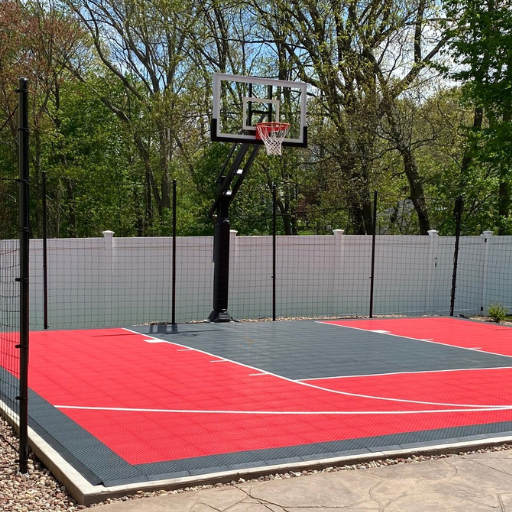
Choosing a suitable type of fencing necessitates thorough examination of the various aspects like the purpose, the material, the aesthetics, and the budget. The latest market research reveals that the worldwide fencing market will hit $41.7 billion by 2027 due to the increasing needs for security, privacy and landscaping done-up. Below is a list of the most popular fencing types along with their main features:
1. Wood Fencing
Wooden fences are a perennial choice owing to their organic look and flexibility. They fit perfectly with all kinds of homes and can be styled with different colors or left plain. On the downside, it is necessary to keep wood fencing up to date with regular maintenance to prevent wood decay, insect invasions, and weather-related wear and tear. Among the various types of wood used for home fencing, cedar and redwood are considered the most environmentally friendly due to their longevity and natural ability to repel bugs.
Average Cost: $15–$30 per linear foot
Lifespan: 15–20 years with proper maintenance
2. Vinyl Fencing
Vinyl fencing is a dark horse gaining ground due to its low-maintenance properties and durability. The weather, termites, and rot cannot do much to vinyl fences, which makes them perfectly suitable for long-term solutions. The option to choose from many colors and designs makes vinyl fences the best choice for a modern and clean aesthetic.
Average Cost: $20–$40 per linear foot
Lifespan: 20–30 years with minimal upkeep
3. Metal Fencing
Metal fences which include aluminum, steel, and wrought iron, provide not only strong security but also an elegant look. Aluminum is light and rust-proof, and therefore, very suitable for coastal areas, whereas steel and wrought iron are even more powerful and secure, thus suitable for places that are at high risk.
Average Cost: $15–$60 per linear foot, depending on the material
Lifespan: 25+ years with periodic maintenance
4. Composite Fencing
Homeowners who are conscious of their environmental footprint can get composite fencing. A mixture of wood fibers and recycled plastics is what makes up this material. It combines the aesthetic appeal of wood with the durability and low maintenance of synthetic materials.
Average Cost: $25–$50 per linear foot
Lifespan: Approximately 25–30 years
5. Chain-Link Fencing
Chain-link fencing is a choice that offers the advantage of a lower price as well as durability; thus, it is still the most frequent material for securing commercial spaces, schools, and sports facilities. Despite its drawbacks in appearance, chain-link fencing can still be made more appealing and private with the help of vinyl coatings or privacy slats.
Average Cost: $5–$20 per linear foot
Lifespan: 20–30 years
6. Bamboo Fencing
Being eco-friendly and aesthetically pleasing, bamboo fencing wins hands down. The material is in high demand for developing a tropical or natural look. On the other hand, it might not be as strong or safe as other materials, so it suits decorative purposes best.
Average Cost: $10–$20 per linear foot
Lifespan: 10–20 years
Factors to Consider:
Purpose: Are you placing security, privacy, or decoration on the top of your priorities?
Climate: Materials like aluminum are, in fact, the best choice for wet, humid, and coastal regions; wood, on the contrary, will require extra care in wet climates.
Budget: Determine how much you will spend at once and how much you will pay for long-term maintenance.
Environmental Impact: Use the available eco-friendly or recycled materials to minimize your ecological footprint.
Choosing the right fencing material and design is not only about guaranteeing practicality but also about being in line with the style of your property. By prioritizing your personal wants and needs, you will make a wise choice that lasts for a long time and enhances the overall attractiveness of your area.
Chain Link Fence: A Popular Option
Chain link fencing is still a practical and economical choice among all the fencing alternatives for residential, commercial, and industrial properties. It is made from galvanized or coated steel wire, thus offering a durable and low-maintenance solution that is suitable for various uses. At present, market research reports that chain link fencing runs from about $8 to $18 per linear foot installation, thus the choice becomes easier, seeing that it is still a cheaper fence than most others made of different materials.
Advantages of Chain Link Fencing
Affordability: In addition to being budget-friendly, chain link fencing is highly advantageous in case of large areas or long perimeters without sacrificing quality.
Durability: Chain link fences made of galvanized or vinyl-coated steel resist rust and corrosion thus giving them a long life even in extremely difficult climatic conditions.
Low Maintenance: These fences do not need much care, the care required is usually just cleaning or a little repair work now and then.
Visibility & Security: Chain link fences are able to maintain a good view over the area around and at the same time provide a secure boundary, this is the reason that they are widely used in schools, sports grounds, and commercial areas.
Versatility: Chain link fences are available in various heights, gauges, and coatings, thus they can be customized to cater to different needs like keeping pets in or marking the line between properties.
Market Trends and Updates
Newer developments are gradually increasing the popularity of chain link fences. Vinyl or polymer coatings not only provide greater color options but also revel that, very much like black and green, other colors are particularly liked as they allow the fence to blend into the surroundings. In addition, the majority of companies are producing eco-friendly materials from recycled plastics and this demand for a more sustainable solution is on the rise.
Considerations
Though very useful, the homeowners might not like the looks of the chain link fences compared to wood and vinyl options. Decorative slats and shrubbery could be added for privacy and aesthetic enhancements if the fence is unattractive.
In a nutshell, chain link fencing still is a convenient choice for all those who look for a fence that is affordable, durable, and easy to install.
Other Fencing Options for Basketball Courts
When it comes to fencing for basketball courts, there are various choices that each offer new benefits to meet different needs and preferences. Below are five different fencing options to think about:
Wooden Fences
Wooden fences have a warm and traditional look, blending in to the environment. They can provide fairly good privacy, but will probably need an ongoing maintenance program, like painting or staining, to keep them from being ruined by the weather.
Vinyl Fences
Vinyl fences are considered a durable and low-maintenance option, and they are a fancy alternative that comes in several colors and styles. They are impervious to the elements and do not bend, but they may still present a costlier initial investment than other options.
Welded Wire Fences
Welded wire fences are incredibly strong and secure; thus, they are perfect for places that require strong protection. They allow light through while being tough, which is why they are often found on professional-grade courts. They do not need much care and they are a budget-friendly choice.
Mesh Fencing
Fencing made of mesh is a preferred option in the basketball court industry because of its flexible structure and customization possibilities. It ensures great ventilation, thus the court remains supplied with fresh air all the time. Besides, it can be painted to provide a resistive layer in case of rust and to match the look of the surroundings.
Composite Fencing
Composite fencing is made from a blend of wood fibers and recycled plastics, making it an environmentally friendly option. It has the same aesthetic appeal as wood but is much more resistant to weather, insects, and rot, thus making it a low-maintenance choice.
All of these fencing options have particular benefits that could be utilized to create a customized Basketball court meeting both functional and aesthetical needs.
Comparing Fencing for Tennis Courts and Basketball Courts
Parameter | Tennis Courts | Basketball Courts |
|---|---|---|
Purpose | Contain tennis balls | Contain basketballs |
Height | 3-4 meters | 4-5 meters |
Material | Chain link, galvanized steel | Chain link, galvanized steel |
Durability | Weather-resistant, long-lasting | Weather-resistant, long-lasting |
Privacy Options | Add vines for privacy | Add vines for privacy |
Customization | Adjustable height and design | Adjustable height and design |
Safety | Protects players and passersby | Protects players and passersby |
Aesthetic Appeal | Enhances court appearance | Enhances court appearance |
Maintenance | Periodic cleaning and inspections | Periodic cleaning and inspections |
Cost | Affordable chain link fencing | Affordable chain link fencing |
Determining the Right Height for Your Fence
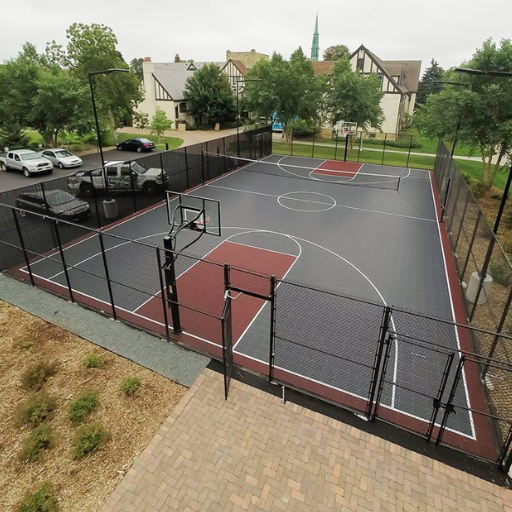
The height of a fence that is considered appropriate usually largely relies on the particular requirements of the area which is being enclosed. A fence height of 10 to 12 feet is common for basketball courts. This height not only helps keep the ball within the court but also protects nearby areas from accidental involvement in the gameplay. As a matter of fact, this height no longer causes significant interruptions. Nonetheless, in the case of less-busy community courts or spaces where the area is tight, an 8-foot fence could be sufficient.
When it comes to tennis courts, the advisable height of the fence may not be that different from the previous case. The standard fencing height for tennis courts is 10-12 feet. The entrances and gates designed for players' movement and access are often made at a height below this. Some places may even justify using a lower 6-feet fence on the ends if the surrounding area of the court is spacious enough to allow it.
The material always determines the extent of a height advantage one gains because stiffer materials can maintain their shape at higher elevations. An investigation into the sports facilities by the constructors revealed that 80% of the outdoor courts are fenced off at a height of at least 10 feet to minimize activities and disruptions.
In conclusion, you should consider the court's use, the environment of the location, and the local regulations when deciding the height of the fence. The end should be that both functionality and practicality are met.
Standard Heights for Basketball Court Fences
In terms of standard heights for basketball court fences, I suggest going for fences that are no less than 10 feet tall. Such a height not only restricts the balls from going out of the court during the intense play but also creates a situation where there are very few disturbances in the areas around the court. Nonetheless, the specific height must be determined by how the court will be utilized, the surrounding environment, and any applicable rules and regulations in that particular place.
Factors Influencing Fence Height
Court Usage
The height of the fence largely influences the primary use of the basketball court. For example, in professional or competitive games, usually, the fence remains quite tall (10-12 feet) because of the high-energy gameplay that needs to be managed, while for casual players the court with a fence of just about 6-8 feet will still be high enough.
Location and Surroundings
Urban areas or courts next to residential neighborhoods might need high fences to prevent basketballs from affecting surrounding properties or traffic. On the other hand, rural or open spaces can have lower fences without any problems.
Player Demographics
The courts frequented by children or casual players do not require so high fences as the ones that adult professionals mainly use. Maintaining the height in accordance with the average gameplay intensity reinforces usability and at the same time avoids overbuilding.
Safety Concerns
The higher the fence, the more safety it offers as it keeps both players and spectators inside a regulated area. This is a major concern in areas near main roads, where unintentional collisions or balls going out of bounds could have damaging consequences.
Regulatory Requirements
Local building codes or sports regulations might specify particular fence heights. For example, certain areas may have safety requirements that require public courts to have at least a certain fence height to minimize liability. Always check with local rules before settling on a design.
Local Regulations and Requirements
Whenever a sports court undergoes a new design or construction, its local regulations and building codes are the main considerations for ensuring both compliance and safety. The following guidelines report some key factors and details:
Fence Height Requirements
A lot of local building codes mention minimum fence heights for sports courts as required. So, public basketball or tennis courts often need to be fenced off with at least 10-12 feet high fences to keep the balls on the property and for safety reasons. However, the specific measurements may change by jurisdiction, so it is very important to get advice from the planning department in your area.
Surface Material Standards
Some states even require that certain kinds of materials be used only for sports surfaces to be considered safe and durable. For instance, tennis courts need to have asphalt or concrete foundations with acrylic coatings to eliminate injuries from uneven surfaces and to provide uniformity. Make certain to acquire materials that comply with the ASTM (American Society for Testing and Materials) standards.
Accessibility Requirements (ADA Compliance)
Public sports facilities are subject to the accessibility regulations of the Americans with Disabilities Act (ADA); thus, the facilities will need to have ramps, wide doorways, and pathways for wheelchair users. Besides, the areas set for seating may have to be made to be inclusive.
Lighting and Electrical Safety
Lighting for outdoor courts is sometimes subject to local ordinances. As an example, California rules that light must be directed downwards thus reducing light pollution and limiting the discomfort created in the adjacent residential zones. Moreover, all electrical work must be performed by a licensed expert who will then inspect the work and certify that it meets National Electric Code (NEC) standards.
Permits and Zoning Restrictions
Usually, before a sports facility can be constructed, obtaining the required permits is the first step. Zoning restrictions might be in place in certain neighborhoods to limit noise, traffic, and environmental impact, especially in residential areas. The zoning application may call for the submission of detailed plans and an environmental assessment that refers to the latter regulations.
Noise Ordinances
Noise from sports activities is one of the reasons many cities have regulations to control it. Residential areas usually have a daytime level of 55 decibels and a nighttime level of 45, which are fairly typical for maximum noise levels, although the exact thresholds depend on each specific city's laws. Sometimes, noise-reduction fencing or landscaping may be needed to meet the requirement.
It is very important to keep in touch with these regulations, since non-compliance could lead to a delay of the project, a fine, or a need for expensive changes. Information can mainly be sourced from local government websites, planning departments, and professional organizations such as USTA and NRPA. Always make it a point to conduct a meticulous examination and seek professional advice during the project planning process to ensure all stipulated standards are met.
Installation Considerations for a Basketball Court Fence
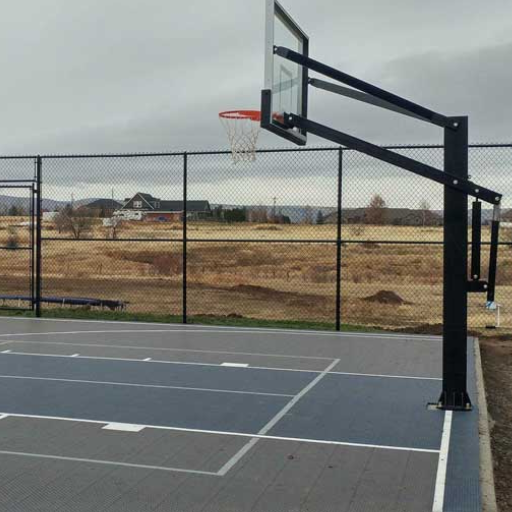
When it comes to installing a basketball court, a fence is one of the things worth considering strongly as it can imbibe a court with great traits like durability, safety, and usefulness. Fencing material, fence height, spacing and clearance, wind resistance and stability, and access and security are five factors that should be carefully considered before making the final decision.
Material Selection
The fencing material has to provide strength and resistance to the weather. Galvanized steel, vinyl-coated chain-link, or aluminum are the most common and widely used materials. Galvanized steel has super durability and can get along with the most extreme weather conditions. On the other hand, vinyl-coated fencing has the advantage of being resistant to rust and at the same time looking good.
Height of Fence
The purpose of the fence will dictate its height. The typical height of the fences for a basketball court is about 10 to 12 feet, preventing a ball from escaping the court area. However, if the court is situated quite close to a residential area or a busy public spot, a taller fence might be needed.
Spacing and Clearance
In player protection, it is important to have proper spacing between the fence and the court. During the game, there should be no contact between the players and the fence. It is recommended that along the sideline and baseline at least 3 to 4 feet clearance is kept.
Wind Resistance and Stability
A wind-resistance and stability fence is a must in a basketball court. Wind-resistant posts should be used, and secure anchoring systems should be in place. If the court is in a windy area, consider installing windbreaks.
Access and Security
Access should be provided to players, maintenance staff, and emergency responders through points of entry like gates. To enhance security during non-operational hours and to prevent unauthorized entry, gates should be lockable.
By taking into account these factors, the basketball court fence can achieve long-term functionality, safety, and low maintenance.
Cost Considerations for Installing a Basketball Court Fence
Installing a fence around a basketball court can be great fun and a big project. But when planning the installation of a basketball court fence, it is very important also to take into consideration the cost-related factors in order to have a good quality project even within budget A proper an installation budget. Given below are five major cost factors to consider:
Material Selection
The choice of materials for the fence will be the first and major factor determining the price. Chain link fences are usually below the average in price, while wrought iron or vinyl options may turn out to be pricey because of their elegance and durability.
Fence Height and Dimensions
Higher fences and larger areas for courts require more materials, so costs will go up. E.g., a normal 10-foot fence around a full-sized court will cost a lot more than a 6-foot fence around a half-court.
Labor Costs
The cost of installation can vary depending on how complicated the project is and where it will be done. Skilled labor will be the factor that guarantees a good installation, but at the same time, its cost will be high.
Accessories and Features
Adding features like gates, logos, padding, or windscreens, etc., will also lead to an increase in overall costs. For example, gates with a locking mechanism provide higher safety but they are also higher in price.
Maintenance and Longevity
Using materials that require little maintenance will reduce costs over time, although the initial purchase will likely be above average. For instance, powder-coated or galvanized steel that does not rust requires less service; therefore, the initially high cost of buying the material is balanced out over time.
Once the above factors are recognized, the decision-making process becomes easier and the budget table can be set right for the installation of a basketball court fence.
Installation Services: What to Expect
In the installation of basketball court fences, understanding the process and key factors might help set very clear expectations. So, here is an extensive list of all the things you can expect:
Site Assessment and Preparation
The first thing that usually happens when the installation is about to begin is a thorough site assessment by the professionals. The things that are included in this are the measurement of the court, the evaluation of the condition of the ground, and the locating of the obstacles that might be in the way, like the underground utilities and uneven terrain. It has been reported in a recent survey that the proper site preparation can minimize the incidence of installation errors by as much as 20%.
Material Delivery and Handling
Once the buyer has decided on his fencing materials—the common choices being chain-link, mesh, or steel panels—these materials are delivered to the site. The most efficient contractors are the ones who ensure that no material is damaged and proper storage is given to prevent any chances of warping or rusting. In general, the timelines for delivery of materials can take anywhere from 3-7 days, depending on the supplier's location and the availability of the materials.
Post Installation
The second step is setting the posts, which is the most important part of a basketball court fence. First, the marking is done for post locations; then holes are dug, and the posts are set in concrete to provide. According to industry guidelines, it is advisable to space the posts no more than 10 feet apart for maximum support. This process usually takes a while since the concrete needs to cure properly which will take 24-48 hours.
Fence Assembly
Once the posts are up and secured, the fencing material that you chose is then affixed to establish the enclosure. Whether it's chain-link fencing being attached or steel panels being secured, fencing professionals use specialized tools and technologies to ensure consistent tension and accurate alignment. Not only does a well-assembled fence last longer, but it is also safer.
Gates and Finishing Touches
Gates are one of the main features that lead to the increase in the functionality of the fence and they are usually incorporated into the design. The installers will then be very careful in aligning and securing the gates with the posts so that they will operate smoothly and have excellent locking mechanisms. The extra finishing, such as protective coatings or padding, is applied around the fence as needed to customize it further.
Quality Inspection
The fence undergoes a detailed inspection for safety and aesthetic standards before the project is declared complete. The industry experts say that inspection after the installation can help spot issues like loose fasteners or uneven sections that will eventually lead to reduced repair needs.
Choosing professional basketball court fence installation not only assures high-quality results but also provides tranquility. A strong and durable fence that is built according to your specifications will be a part of your court that will be created with careful planning, adherence to industry standards, and meticulous execution.
Proper Maintenance of Your Court Fence
Proper care and maintenance are the cornerstones of the longevity and optimal performance of your basketball court fence. Regular maintenance not only keeps the fence aesthetically pleasing but also guarantees safety and usability for a long time. Here are five very important maintenance tips:
1. Clean the Fence Regularly
The fence may collect dirt and debris that eventually lead to rust or damage. Clean the fence at least every few months with soap and water to remove dirt and preserve the fence's appearance.
2. Look for Signs of Damage
Make a habit of inspecting the fence regularly for any signs of damage including loose bolts, broken links, or bent sections. By addressing these problems as they arise, you not only prevent further damage but also keep the fence very secure.
3. Take Action to Prevent Rust
The metal fences can easily rust no matter the weather conditions, and this is especially true in humid or rainy places. Applying rust-resistant coatings or paint regularly can serve as a protective measure for the fence and extend its lifespan.
4. Moving Components Should Be Lubricated
In case the fence has gates with hinges or locks, make sure that these components are lubricated to avoid them making noise and to prevent wear. Always use high-quality lubricants that are suitable for outside use.
5. Remove Weeds & Trim Nearby Plants
Plants or branches that are overflowing can put pressure on the fence structure which might eventually lead to damage. Regularly trim the vegetation around the fence to reduce strain and keep the boundary clear.
The regular implementation of these maintenance practices will not only save you time and costs but also keep your court fence durable and reliable in the long run.
Frequently Asked Questions (FAQ)
What is the ideal height of a fence around the basketball court?
A ten-foot high fence surrounding a basketball court would be the perfect height. The ball would not be able to go out of the playing area, and neither would the players and audience feel cramped. Moreover, if certain places around the court might cause balls to leave the court then a higher fence could be used.
What are the advantages of putting up a fence around the basketball court?
Fencing is vital for securing the game as it prevents the ball from going out of the court. It also enhances the playing experience for both players and spectators. In addition, the right fencing can do wonders for the visual appeal of an outdoor basketball court, making it attractive to the neighborhood.
What type of fence is best for a basketball court?
Among the best fences for a basketball court are chain link and mesh fences, as they offer durability and good visibility. Chain link fencing is usually chosen as the best option because it is lightweight, rustproof, and economical. Welded wire fencing is also a good option, giving a long-lasting enclosure that tolerates stress and strains.
How does fencing improve the overall playing experience on a sports court?
A fence around a basketball court will catch the ball, preventing it from reaching the players’ or spectators’ areas. Not only does this lead to a smooth game but it also helps to keep the concentration of the players. Furthermore, having a dedicated area for the audience will enhance their experience, as they will be able to see the game without interruption.
What factors should I consider when selecting fencing?
When choosing the right fence for the basketball court, consider height, material, and aesthetics as key factors to evaluate. The fence should be tall enough to contain the ball, the material should be strong and easy to take care of. In addition, the attractiveness of the wall can contribute to the overall beautiful look of the sports field.
Are there cost considerations when installing a basketball court fence?
There are definitely a few cost considerations when the fencing around the basketball court is installed. The long-term cost can be significantly affected by the type of fencing selected, whether chain link or wooden fencing. The installation costs may vary depending on the complexity of the project and the specific requirements of your court.
Can a fence around a basketball court be a reason for the wear and tear of the court?
Proper fencing can indeed limit the court's wear and tear, as it will prevent the balls from leaving the court. This containment will result in the court being appropriately maintained, thus requiring fewer repairs. Besides, engaging in these active sports like basketball is much more beneficial since they are usually high-impact.
What features should I look for when considering fences that are both visible and durable?
When selecting a fence with good visibility and longevity, go for materials that are both lightweight and strong, such as chain link or welded wire. These options not only provide a clear view of the court but also have good resistance to the weather and impacts from the game. Moreover, the right fence should be built to require minimal maintenance while ensuring a long life.
Tags: How high should a fence be around a basketball court?
